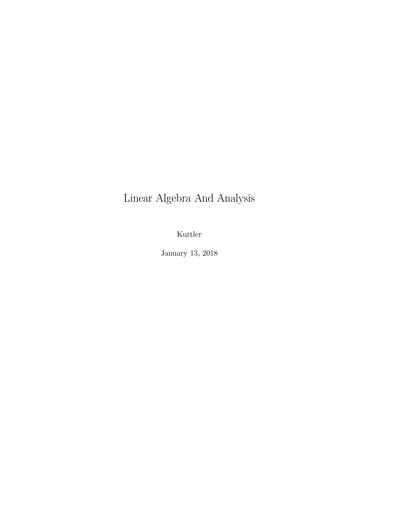
Linear Algebra And Analysis
This is on linear algebra and its interaction with analysis. It emphasizes the main ideas, both algebraic and geometric and attempts to present these ideas as quickly as possible without being overly terse.
Tag(s): Linear Algebra
Publication date: 13 Jan 2018
ISBN-10: n/a
ISBN-13: n/a
Paperback: 619 pages
Views: 5,276
Linear Algebra And Analysis
 This is on linear algebra and its interaction with analysis. It emphasizes the main ideas, both algebraic and geometric and attempts to present these ideas as quickly as possible without being overly terse.
This is on linear algebra and its interaction with analysis. It emphasizes the main ideas, both algebraic and geometric and attempts to present these ideas as quickly as possible without being overly terse.
Publication date: 13 Jan 2018
ISBN-10: n/a
ISBN-13: n/a
Paperback: 619 pages
Views: 5,276
Document Type: Textbook
Publisher: Self-publishing
License: n/a
Post time: 15 Feb 2021 01:00:00
Kuttler wrote:This is on linear algebra and its interaction with analysis. It emphasizes the main ideas, both algebraic and geometric and attempts to present these ideas as quickly as possible without being overly terse. The emphasis will be on arbitrary fields in the first part and then later geometric ideas will be included in the context of the usual fields of R and C. The first part is on linear algebra as a part of modern algebra. It avoids cluttering the presentation with geometric and analytic ideas which are really not essential to understanding these theorems. The second part is on the role of analysis in linear algebra. It is like baby functional analysis. Some analysis ideas do in fact creep in to the first part, but they are generally fairly rudimentary, occur as examples, and will have been seen in calculus. It may be that increased understanding is obtained by this kind of presentation in which that which is purely algebraic is presented first. This also involves emphasizing the minimum polynomial more than the characteristic polynomial and postponing the determinant. In each part, I have included a few related topics which are similar to ideas found in linear algebra or which have linear algebra as a fundamental part.The third part of the book involves significant ideas from analysis which depend on linear algebra.
The book is a re written version of an earlier book. It also includes several topics not in this other book including a chapter which is an introduction to modules and rings and much more material on analysis. However, I am not including topics from functional analysis so much. Instead, I am limiting the topics to the standard analysis involving derivatives and integrals. In fact, if everything which uses linear algebra were presented, the book would be much longer. It is limited to topics that I especially like and emphasizes finite dimensional situations.
Tweet
About The Author(s)
Kenneth Kuttler is Professor in the Department of Mathematics at Brigham Young University. His primary area of research is Partial Differential Equations and Inclusions. He works on abstract methods for determining whether problems of this sort are well posed. Lately, he has been working on the mathematical theory of problems from contact mechanics including friction, wear, and damage. He has also been studying extensions to stochastic equations and inclusions.

Kenneth Kuttler is Professor in the Department of Mathematics at Brigham Young University. His primary area of research is Partial Differential Equations and Inclusions. He works on abstract methods for determining whether problems of this sort are well posed. Lately, he has been working on the mathematical theory of problems from contact mechanics including friction, wear, and damage. He has also been studying extensions to stochastic equations and inclusions.